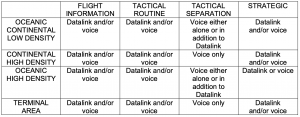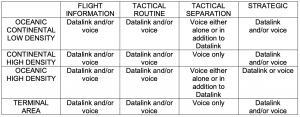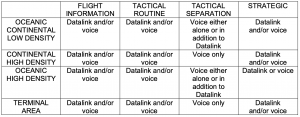48TH ANNUAL CONFERENCE, Dubrovnik, Croatia, 20-24 April 2009WP No. 89Datalink – Review Policy on Air Ground DatalinkPresented by TOC |
Summary
Data link communications between pilots and controllers will not totally replace voice communications and both will coexist in the future, using different technologies and networks that must meet safety and performance requirements and address human factors issues. This paper reviews the current IFATCA Policy on air ground data link, of which the majority of statements remain valid. However, in the light of recent developments some of the Policy Statements are proposed for deletion.
Introduction
1.1 Controller Pilot Data Link Communications (CPDLC) provide controllers and pilots with position reports, text dialogues and more advanced services, thus reducing voice communications. Voice will never disappear, but it may not be the primary means of communications in a distant future. For that evolution, data link networks need sufficient performance and human interfaces must be designed according to human capacities.
1.2 This paper will review the different IFATCA Policy aspects according to recent data link technologies or standards developments and propose a Policy update to reflect the evolution of the voice and data link coexistence.
Discussion
2.1 IFATCA Policy
2.1.1 IFATCA Air-Ground Datalink Policy presented below deals with many data link issues that this paper will regroup for clarity during the discussion:
|
“Voice communications be retained as a communications channel in all circumstances. The table below indicates the suitability of voice communications and data link communications as the primary communications medium, and where the use of voice and data link communications together is acceptable for particular airspace users. In the event that an area experiences growth such as to place it into a different domain, then the appropriate communications medium shall be provided.
Where data link communications are in use, that access to the aircraft is subject to a system of priorities. The Controller who has jurisdiction for that flight shall have the highest unassailable priority subject to emergency messages. That the necessary ground networks are in place, with satisfactory resilience to system failure and secure to resist unlawful interruption, prior to the introduction of data link communications. The ground systems should satisfy the appropriate performance criteria for safety critical reasons. Interface devices required for the use of data link communication are designed such as to not add to controller workload. Voice communications should be the preferred communications medium to be used in the event of an emergency. This shall not preclude the use of data link communications if deemed appropriate by those involved. An alerting device is provided to assist human operators to respond to voice communications when they are not the primary communications medium. Future developments of data link services in the provision of ATM services must support the cognitive needs, and be compatible with, the capabilities of the human. The performance of aircraft on board data link services will be such as to provide the required level of performance for safety critical system, inter alia to operate from standby power sources. Information regarding the equipage/non-equipage of data link is notified to controllers at the operational position in the appropriate manner. The number of types of data link equipage in a single airspace, should be kept to an absolute minimum. ATC personnel should not be required to distinguish between different levels of data link equipage in the same airspace.” |
2.2 Voice communications
2.2.1 The Policy focuses on the need to maintain voice communications. CPDLC allow the exchange of text messages designed to mimic the voice messages, in order to help pilots and controllers select and understand them easily. The aim has never been to remove the direct voice link between pilots and controllers.
2.2.2 The best example is found in oceanic communications that have maintained the traditional poor quality High Frequency (HF) communications through Flight Service Stations (FSS). An FSS is a radio operator that is not a controller but operates on HF frequencies to relay messages such as clearances or position reports between pilots and oceanic control centres. Data link communications were progressively implemented with the Future Air Navigation Systems (FANS). FANS is an upgrade of the onboard Aircraft Communication Addressing and Reporting System (ACARS) avionics and a link with the Flight Management System (FMS) that allows the pilots to automatically transmit their position reports via Automatic Dependant Surveillance – Contract (ADS- C) and exchange text messages (CPDLC) with the oceanic centres. FANS use digital HF (High Frequency), VHF (Very High Frequency) and International Mobile Satellite Organization (INMARSAT) satellites data links to connect to the Aeronautical Radio, Incorporated (ARINC) and the Société Internationale de Télécommunications Aéronautiques (SITA) networks that relay the data link messages to the oceanic ground centres. The FANS introduction in oceanic airspace has reduced but not eliminated voice communications.
2.2.3 Furthermore, within the North Atlantic (NAT) region, aircraft equipped for INMARSAT Satellite Communications (SATCOM) voice communications are allowed to use such equipment for emergencies and non-routine situations, e.g. loss of HF communications. Pilots can either contact the FSS HF operators or directly the oceanic centres in case of emergency. The SATCOM telephone numbers are published in national Aeronautical Information Publication (AIP).
2.2.4 During a trial in Canada the possibility to use INMARSAT commercial voice communications for routine Air Traffic Services (ATS) operations was investigated. A satellite voice task force implemented by INMARSAT and the ICAO North Atlantic Implementation Management Group (NAT IMG) has defined the technical modifications (enhanced security measures, automated dialling systems at radio facilities) and air crew & operator guidance material. This was done in order to conduct another trial with five airlines and all NAT radio stations in May 2007, with some positive results that could lead the ICAO North Atlantic Systems Planning Group (NAT SPG) to issue recommendations for the use of satellite voice communications for ATS routine operations.
2.2.5 Oceanic HF third party stations and continental VHF stations are not likely to be removed in the short or medium term. Besides this, future satellite voice communications will offer an additional voice channel with a better digital quality than current HF frequencies. Data link complements or improves voice communications.
2.2.6 Based on the arguments above, TOC has concluded that the first related Policy statement remains valid:
| ”Voice communications be retained as a communications channel in all circumstances.” |
2.3 Voice and Data
2.3.1 IFATCA Policy recommends the use of voice in case of emergency, without rejecting the use of data link. To transmit crucial information in emergency situations, voice is instantaneous and no new development in data link has offered a more flexible means of communications. Data link cannot be as fast as voice, but it can help in case of an aircraft’s radio failure as a backup means of communications. In the event of a stuck microphone, a CPDLC message can be sent to several aircraft at the same time to ask them to check their microphone. For surveillance, Automatic Dependent Surveillance – Broadcast (ADS-B) offers a possibility to the pilot to send an emergency signal similar to the 7500, 7600 and 7700 mode A emergency codes. However, this emergency flag does not give the exact nature of the emergency, which must be confirmed via voice.
2.3.2 Based on the arguments listed above, the following related Policy statement remains valid:
| “Voice communications should be the preferred communications medium to be used in the event of an emergency. This shall not preclude the use of data link communications if deemed appropriate by those involved.” |
2.3.3 IFATCA Policy considers four airspaces domains:
- oceanic and continental low density
- continental high density
- oceanic high density
- terminal area
During the Policy elaboration, these domains were considered by ICAO and the FANS Committee and used in the IFATCA Policy. A new airspace classification has been developed for the environment definition of mid- and long-term implementations of the Single European Sky ATM Research (SESAR) and the FAA Next Generation Air Transportation System (NextGen), the two major programmes. Eurocontrol and the Federal Aviation Administration (FAA) have initiated a study on the future communications technologies that produced in December 2007 the second version of a document called Communications Operating Concept and Requirements (COCR), considering two phases:
- Phase 1 (target date 2020) is based on existing or emerging data communications services.
- Phase 2 (target date 2030) introduces new services that replace or supplement those in phase 1. Data communications become the standard method of air-ground communications and supports increased automation in the aircraft and on the ground (from the phase 1 ‘management by intervention’ to the phase 2 ‘Management by planning and intervention by exception’).
2.3.4 Voice communications remain central in phase 1, but in Phase 2 voice is only used for exceptional circumstances or in areas with no data communications. Five airspace domains have been selected: airport (APT), Terminal Area (TMA), En Route (ENR), Oceanic Remote and Polar (ORP) and Autonomous Operations Area (AOA) where aircraft self-separate without any ATC. Table 1 is a summary of the phase 1 environment:

Table 1 – Phase 1 environments
For this phase 1, voice is retained as primary means of communications, except in ORP airspace where data link is the primary but not the only means of communication. Third- party FSS operators still provide the indirect voice service (via HF or satellite voice) but only for non-routine and emergency situations.
2.3.5 Table 2 represents the evolution of these different environments in phase 2.

Table 2 – Phase 2 environments
Data link has replaced voice communications as primary means of communications in all airspace categories, but voice is still available for non-routine or emergency situations.
2.3.6 The hypothetic emergence of an AOA environment is outside the scope of this Policy since it cannot be discussed without any detailed service description of aircraft self- separation in an entire area without controller intervention. The only self-separation considered at the moment is a two aircraft separation on the controller’s initiative with CPDLC messages. It must be noted that this phase 2 relies heavily on Trajectory Based Operations (TBO) both in SESAR and NextGen. The concept is that all the 4D path waypoints (position and time) are negotiated before departure and available to the ground systems for conflict prediction. The controller’s primary responsibility during TBO will be to respond to problems predicted by the ATC automation, such as conflicts between aircraft and other aircraft, weather, or flow management constraints. He will issue route modifications via data link and use the voice channel for non-routine or emergency situations.
2.3.7 The aim of this Policy review is not to discuss the feasibility of TBO but to consider which communication means will be used in the different airspace domains and technological contexts. It is understandable that, if TBO are implemented, then voice communications will be greatly reduced for route and level changes, speed constraints, etc. This implies that voice may not be any more the primary communications means in this context. It does not imply that voice communications will be obsolete.
2.3.8 This long term approach requires a simplification of the current Policy, to reflect the change from the current data link services to the more advanced implementations using 4D trajectories in NextGen and SESAR type concepts. Data link communications may become suitable as primary means of communications in future environments with increased trajectory prediction and data link services for trajectory negotiations, information delivery, etc.
2.3.9 To take into account the long term approach where data link may become suitable as primary means of communications, it is suggested to remove from the IFATCA Policy the following statement and table:
| “The table below indicates the suitability of voice communications and data link communications as the primary communications medium, and where the use of voice and data link communications together is acceptable for particular airspace users. In the event that an area experiences growth such as to place it into a different domain, then the appropriate communications medium shall be provided.”
|
2.4 Performance
2.4.1 IFATCA Policy addresses the need for reliable performance of the data link networks and technologies. An operational example will illustrate the need to give priority to aeronautical communications.
2.4.2 Data link implementations have started with the ACARS text messages to provide pilots with departure clearances and Automatic Terminal Information Service (ATIS) through ARINC and SITA networks composed of digital VHF ground stations. The second step has been the FANS onboard upgrade and a link between ARINC and SITA networks with HF, VHF and INMARSAT satellites to allow ADS-C automatic position reports and CPDLC for oceanic operations. In these remote areas, there is usually no radar or VHF coverage and only poor quality HF communications to relay messages through third party FSS operators. Losing the satellite link would mean relying only on HF position reports and messages relays.
2.4.3 Each INMARSAT satellite is in communication with at least two Ground Earth Stations (GES) for redundancy: Elk (Norway), Aussaguel (France), Perth (Australia), Santa Paula –USA). Picture 1 represents the different satellites and GES.
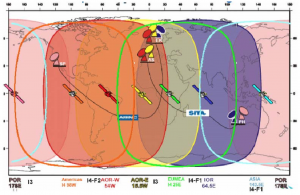
Picture 1 – INMARSAT satellites and GES
2.4.4 In February 2007 the Goonhilly (United Kingdom) GES was closed down, which means that Aussaguel (France) GES is the only station available for NAT satellite communications. Neither SITA and ARINC have the sufficient means or capacity to act as a backup in the event of a catastrophic failure of Aussaguel GES, which could result in oceanic controllers losing satellite contact with a whole set of FANS aircraft at the same time, leaving only HF 3rd party communications with FSS operators as back-up.
2.4.5 Oceanic communications via INMARSAT satellites are managed by GES operators who sell the satellite services to SITA and ARINC. The number of GES is reduced because replacing old components implies costs that do not seem justified for GES operators, and providing redundancy between GES implies reducing the bandwidth available for primary users, thus increasing the cost of communications for airlines. The economic logic of GES operators to merge and shut down duplicate stations to reduce costs and offer lower prices is amplified by the desire of airlines to obtain the lowest possible prices for satellite communications. The NAT SPG is considering the possibility for oceanic Air Navigation Service Providers (ANSP) to compensate GES operators for the cost of equipping GES with enough capacity to be used as backup.
2.4.6 This illustrates the risk that a patchwork of private networks can represent for ATS data link communications in case of emergencies. The following IFATCA Policy statement remains valid:
| “Where data link communications are in use, that access to the aircraft is subject to a system of priorities. The Controller who has jurisdiction for that flight shall have the highest unassailable priority subject to emergency messages.” |
2.4.7 The FANS data link initiative was the first to offer data link services to oceanic flights, but lacked some key safety features such as a proper logical acknowledgement or a message mis-delivery protection to make sure that a message is sent to the right aircraft and is actually displayed to the pilot.
2.4.8 To avoid the emergence of further networks and technologies, ICAO has published in ICAO Annex 10 Aeronautical Telecommunications Standards and Recommended Practices (SARPs) for an open interconnection network called the Aeronautical Telecommunications Network (ATN). ATN started in the USA (Miami ACC, from 2002 to 2004) and Europe (Maastricht UAC since 2004) and has been selected for continental data link implementations in SESAR and NextGen.
2.4.9 ATN and FANS are two different networks that are not compatible, which means that an aircraft equipped with FANS operating in oceanic areas cannot logon to a continental ATN network. The other way around, a NextGen or SESAR aircraft, equipped with ATN, cannot use data link in oceanic airspace with oceanic ANSPs current FANS ground systems.
2.4.10 Accommodation is possible by using dual stacks in ground systems, to communicate with both FANS and ATN aircraft, but this raises several safety and operational issues in continental airspace (as detailed in IFATCA WP96 2007): no logical acknowledgement or onboard timers for FANS aircraft, no 24 bit aircraft address in FANS message headers, free text translations of messages for FANS aircraft with different response attributes, etc.
2.4.11 On the other hand, current ATN onboard systems are not linked to the FMS which prevents the aircraft from sending automatic position reports (ADS-C) and the controller from uploading new routes propositions to the pilots (as planned in TBO.
2.4.12 To help future convergence between the two networks towards a next generation network, the ICAO Data Link Steering Group (DLSG) has created the ATN Accommodation Drafting Group (ADG) which recommends separating the data link applications from the network layers. It is already the case for FANS and ATN CPDLC so the ADG is currently working on the definition of ADS-C (automatic position reports) to provide the same layers separation between the application and the network. Convergence of FANS and ATN applications is more difficult because of the interoperability issues impacting the users. FANS and ATN slightly different message sets requiring free text translations, FANS messages in text format as opposed to ATN messages binary format, etc.
2.4.13 To help ANSP implement data link services, the top-down approach has been chosen. ANSP will follow standards defined for all data link services in continental and oceanic operations by two independent not-for-profit corporations, the American Radio Technical Commission for Aeronautics (RTCA) and European Organization for Civil Aviation Equipment (EUROCAE). When implementing data link services, ANSP must check if the technologies, networks and companies they select actually comply with the RTCA and EUROCAE standards published in “Safety and Performance Requirements [SPR] Standards for Air Traffic Services in Oceanic and Remote Airspace” (EUROCAE Document 122 / RTCA Document 306 (December 2007)), and “in Continental Airspace”. (ED-120/DO-290, May 2004)
2.4.14 These standards include Required Communication Performance (RCP) for all the data link services. These RCP come from ICAO Doc 9869 Manual on Required Communication Performance and characterize the performance required for communication capabilities to support ATM functions without reference to any specific technology and are open to new technologies. An RCP type consists in values for communication transaction time, continuity, availability and integrity. Table 3 contains the different RCP types and associated values.

Table 3 – different RCP types
2.4.15 The aim of these RCP is to provide a benchmark to set requirements for specific airspaces or technologies. Based on ED-122 and ICAO Doc 9869 Manual on Required Communication Performance, NAT and South Pacific ANSPs are considering RCP 240 and 400 for oceanic operations. RCP 240 will be used by a FAA Group to assess the viability of Iridium satellites data communications for aeronautical services.
2.4.16 The ATN has been defined by ICAO to offer a robust and open network architecture with key features that were missing in the FANS initiative. The data link services safety and performance requirements are covered by RTCA and EUROCAE standards. Required communications performances have also been covered by ICAO. All these standardisation efforts contribute to the safety of data link operations, and the following IFATCA Policy statements remain valid:
| “That the necessary ground networks are in place, with satisfactory resilience to system failure and secure to resist unlawful interruption, prior to the introduction of data link communications. The ground systems should satisfy the appropriate performance criteria for safety critical reasons.
The performance of aircraft on board data link services will be such as to provide the required level of performance for safety critical system, inter alia to operate from standby power sources.” |
2.5 Human Factors
2.5.1 Besides the networks and technologies used to transmit messages, an important aspect is the interface used to compose and to read messages. Human Machine Interface (HMI) design is crucial when data link shifts communications from aural & vocal to visual stimuli. A pilot or controller immediately notices an incoming call on the frequency but for a new data link message he needs to keep his look on the data link display.
2.5.2 A combination of visual and aural signals has been adopted onboard. For example, during oceanic operations maintaining a constant monitoring watch on HF poor quality frequencies is tedious. The Selective Call (SELCAL) was created in the late 60s to relieve the pilot: each aircraft has a specific SELCAL 4 letters code so the ground station emits the two-tones signal coding the 4 letters corresponding to the aircraft, and a visual and aural signal onboard informs the pilot that he has to establish an HF communication with the ground station.
2.5.3 FANS aircraft have kept the same logic, and pilots are alerted of an incoming message by a flashing blue light in two pushbuttons (ATC MSG) and a specific audio sound (a telephone ringing!) repeated every 15 seconds. They read the message in the Dedicated Control Display Unit (DCDU) and compose an answer on the Multipurpose CDU (MCDU). Picture 2 represents an Airbus cockpit with its different attention getters and data link interfaces.
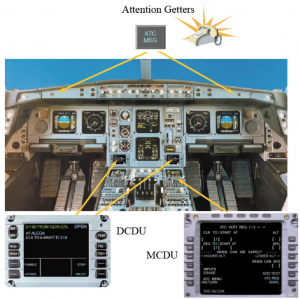
Picture 2 – Airbus cockpit integration of attention getters and data link displays
2.5.4 Ground implementations have no HMI configurations requirements to specify which aural and visual signals have to indicate any new downlink message. But when a pilot receives one or two messages from the controller, we must keep in mind that controllers receive messages from all the aircraft. Attention getters should be as discrete as possible to avoid soliciting the controller every few seconds with a noisy or flashing ‘new message’ signal. A delicate balance must be found between intrusive and hardly noticeable ‘new message’ warnings.
2.5.5 This issue will still be relevant when data link become the primary means of communication. The controller will carefully keep his eyes on his display to communicate with pilots through data link messages, but may forget to monitor to the frequency or simply not realize that the volume is too low to detect a voice call. Every controller has experienced a loss of radio contact with a pilot who had turned down the volume of his radio set.
2.5.6 There are many other HMI issues related to data link communications:
- Pilots lose time when browsing through different pages on their MCDU and may not find the message they are looking for;
- Pilots cannot evaluate the controller workload if they don’t hear anymore the other pilots’ calls on the frequency;
- Pilots may execute a clearance automatically loaded into the FMS (for example a route modification) without reading it properly, and be surprised by the resulting autopilot manoeuvre;
- Controllers can select the wrong level when composing a clearance and not realize their mistake;
- Controllers need a wide display surface to read all the labels, the incoming message window and the message composition window at the same time (without overlapping windows);
- Both pilots and controllers must not spend too much time head-down because of a bad interface design;
- Speed of delivery, clipping of messages, voice intonations convey a lot of information about intention, hesitation, misunderstanding, stress, urgency, etc.
2.5.7 These issues of interface design and loss of situational awareness are only a part of human factors related to data link that would probably require a working paper on their own. The current IFATCA Policy has strong statements about interface design and cognitive needs that remain valid:
| “Interface devices required for the use of data link communication are designed such as to not add to controller workload.
An alerting device is provided to assist human operators to respond to voice communications when they are not the primary communications medium. Future developments of data link services in the provision of ATM services must support the cognitive needs, and be compatible with, the capabilities of the human.” |
2.6 Mixed mode operations
2.6.1 IFATCA Policy requires an appropriate notification to the controller of the onboard equipage or non equipage of data link. It is a difficult task for HMI design to display all the information regarding data link equipage without overloading the controller’s attention.
Picture 3 is an example of the different labels shown to Australian controllers.

Picture 3 – Australian display of different data link surveillance capabilities
On the Australian displays:
- within radar coverage aircraft are displayed as radar tracks.
- continental aircraft equipped with ADS-B are shown with an ADS-B track symbol.
- FANS oceanic aircraft provide automatic position reports via ADS-C.
- outside radar coverage aircraft are shown as flight plan tracks: the position is estimated by the system according to the aircraft type and corrected by wind data. The pilot regularly reports his position to the controller who manually confirms the estimated position.
- aircraft able to communicate via CPDLC are presented with a dash in the label just after the callsign.
It is interesting to note that these labels reflect both the surveillance type (with different track symbols) and the data link communication capability (with the addition of a dash).
2.6.2 Symbols are a more elegant way to convey information about data link equipage than additional letters in the label, but we must keep in mind that track labels must also:
- reflect the aircraft parameters (altitude, squawk)
- allow the controller to update the parameters according to his clearances transmitted by voice
- allow the controller to select, compose and send a data link message
To avoid the overload of track labels with the addition of symbols and letters leading to confusion, the following IFATCA Policy statement remains valid:
| “Information regarding the equipage/non-equipage of data link is notified to controllers at the operational position in the appropriate manner.” |
2.6.3 In the case of mixed mode operations where some aircraft are not equipped with data link such as exempted State aircraft, General Aviation (GA) or aircraft equipped with different data link technologies (FANS or ATN), the controller must know if he can use data link with an aircraft. He should not be presented with different commands and message sets according to the specific data link equipage, as it may happen if interoperability issues are not solved between FANS and ATN message sets.
2.6.4 The optimal solution would be for the controller to ignore whether aircraft is equipped with FANS or ATN and to select only one message in his display’s menu, leaving the ground system choose the appropriate message in the FANS or ATN message set (and not a free text translation, which is more problematic for a safe composition, transmission, integrity checking and preformatted answer). The relevant IFATCA Policy remains valid:
| “ATC personnel should not be required to distinguish between different levels of data link equipage in the same airspace.” |
2.6.5 TOC acknowledges the coexistence of different technologies. Data link has always relied on various technologies such as satellite, digital VHF or mode S 1090MHz. FANS data link has proven successful in oceanic airspace and evolves to comply with continental ATN requirements. Provided that all the safety, interoperability, HMI design concerns are met, new technologies should not be discarded for the simple purpose of reducing the number of data link equipages. Considering the current coexistence of multiple technologies, TOC proposes to remove the following IFATCA Policy statement:
| “The number of types of data link equipage in a single airspace, should be kept to an absolute minimum.” |
Conclusions
3.1 The last ten years have not brought any new major technology ready to replace voice communications. Data link may become the primary means of communications in a 4D trajectory environment, but voice will still be available to pilots and controllers, whether it remains VHF in continental coverage or satellite voice in oceanic areas.
3.2 Data link performance is standardized through RCP to help airlines, avionics manufacturers and implementers select the current and future technologies and sub- networks that fit their continental or oceanic Safety and Performance Requirements.
3.3 Oceanic FANS will not disappear in a near future and we will still have to wait some time for continental ATN implementations with SESAR and NextGen. This multiplicity of technologies should not have consequences on HMI already impacted by data link basic transactions that raise various human factors issues.
3.4 IFATCA Policy is still relevant regarding the use of voice, the data link performance requirements, and the human factors issues. Based on the arguments in this paper, TOC proposes to delete the Policy Statements addressing the coexistence of voice and data link and the number of data link equipages.
Recommendations
It is recommended that;
4.1 IFATCA Policy on page 3 2 1 10 and 3 2 1 11 of the IFATCA Technical and Professional Manual:
“The table below indicates the suitability of voice communications and datalink communications as the primary communications medium, and where the use of voice and datalink communications together is acceptable for particular airspace users. In the event that an area experiences growth such as to place it into a different domain, then the appropriate communications medium shall be provided.
The number of types of datalink equipage in a single airspace, should be kept to an absolute minimum.”
Is deleted.
References
North Atlantic Systems Planning Group 43rd meeting discussions (June 2007).
‘Communications Operating Concept and Requirements (COCR) for the Future Radio System’ version 2 (December 2007).
RTCA SC214 / EUROCAE WG78 ‘Safety and Performance Requirements (SPR) for Advanced ATS Data Communications’ (Draft, August 2008).
EUROCAE ‘Continental SPR Standard’ ED120 (May 2004).
ICAO Doc 9869 Manual on Required Communication Performance, first Edition 2006.
FANS Interoperability Team (FIT) ‘CPDLC Guidance Material’ (March 2005) [Part 6: Human Factors].
ICAO Doc 9694 Manual of Air Traffic Services Data Link Applications, first Edition 1999 [Appendix to Chapter 2: Human Factors].

